“Not going to the Moon and banging on it with my own hammer has been the biggest disappointment in life.” -Gene Shoemaker, co-discoverer of Comet Shoemaker-Levy 9
Don't fret about your taxes here at Starts With A Bang; I'll continue to bring you the Universe for free! (Although I do take donations, and one reward you're sure to get is an early version of April's podcast, for those who don't want to wait!) If you missed anything this past week, don't be afraid to check it out now, including:
- Why is Jupiter hit by so many objects in space? (for Ask Ethan),
- NASA's Cassini reveals the full glory of Saturn's rings (for Mostly Mute Monday),
- The biggest problem with the expanding Universe might be trouble for dark energy,
- How we'll finally wind up testing quantum gravity (a guest contribution from Sabine Hossenfelder),
- Winning a Nobel Prize two kilometers under the Earth (a live-blog extravaganza)
- How to tell a child that the Sun will someday die, and
- Is Stephen Hawking's 'StarShot' really possible?
I've started on the audiobook version of Beyond The Galaxy, so for those with no patience to read, you can hear me reading it to you! And with that said, there's a lot you wanted to know about, so let's get onto our Comments Of The Week!
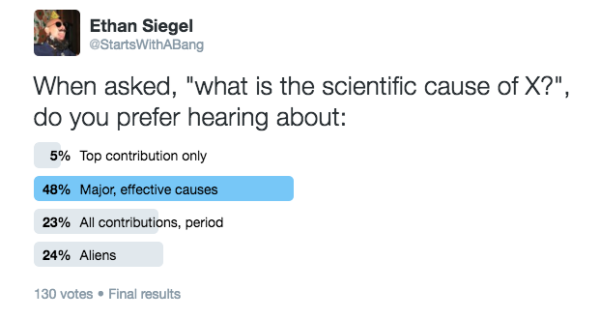 Image credit: the results of our (Twitter) poll, via https://twitter.com/StartsWithABang/status/718899859047079936.
Image credit: the results of our (Twitter) poll, via https://twitter.com/StartsWithABang/status/718899859047079936.
First, the results of last week's poll: only 5% of people wanted to know the #1 cause as a sufficient answer when asked "what causes something" scientifically. 48% agreed with Michael Kelsey from last week, that I should stick to the major causes that are actually effective, while only 23% agreed with the approach I traditionally take, to enumerate and quantify all causes, even the ones that aren't particularly relevant.
Of course, 24% of you said "Aliens." Well, have I got a gift for you.
Yeah, eat your heart out, History Channel.
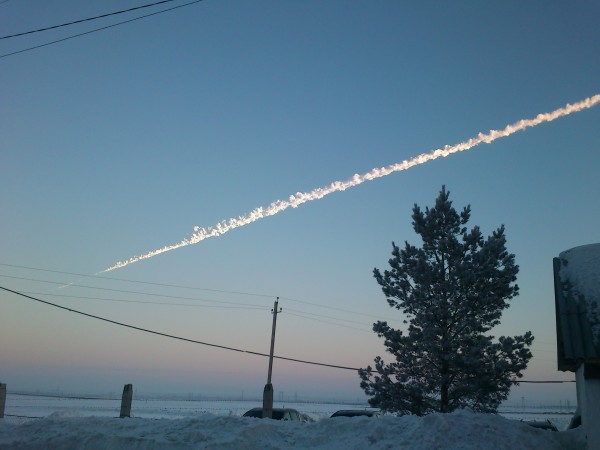 Image credit: Константин Кудинов, under a c.c.a.-s.a.-3.0 license, of the Chelyabinsk meteor in Russia.
Image credit: Константин Кудинов, under a c.c.a.-s.a.-3.0 license, of the Chelyabinsk meteor in Russia.
From Paul Dekous on meteor impacts: "What is the conversion process of a large Meteor when it smashes into a planet? Is it only a crushing and chemical burning process that releases energy, or is there also nuclear fission/fusion conversion of matter? If so, is there radioactive fallout, like for a nuclear bomb? Or does fallout only occurs because of the fuel that is used to make atomic bombs?"
All of the reactions that occur, as far as we know, are chemical/electromagnetic in nature, not nuclear. The energies required for a nuclear reaction are in the ~100 keV range, which would correspond to mean temperatures in the millions-of-degrees range to have particles at the tail end of the Poisson distribution reach those energies. The temperatures reached during a meteor strike -- both from friction with the atmosphere and from the energy of the impact itself -- are about a factor of 100 too low.
Even if you did reach those temperatures (which you don't), the nuclear reactions that could occur would be restricted to whatever materials were left on the comets/asteroids striking us after existing in space for the 4.5 billion years the Solar System has been around. This would be mostly U-235, which is the only known fissile material (fusion is right out, requiring even hotter temperatures) on board. Traces of Uranium and other radioactive materials are found in asteroids, but are exceedingly rare and pose less threat to you in total than the radioactivity from eating a banana.
For when radioactive fallout does occur, I refer you to Michael Kelsey: "Radioactive fallout occurs when a nuclear weapon is detonated at, or very close to, ground level. In those cases, the material of the ground is vaporized (as with a bolide impact), but is also being irradiated with neutrons and gamma rays. The neutrons, in particular, can be absorbed by nuclei and turn them (the latter) into other, usually radioactive, isotopes. It is that process which leads to the radioactive part of nuclear fallout."
But that said, get a relativistic meteor, and we're in trouble! Of course, since kinetic energy goes as velocity squared, we'd be in a lot of trouble anyway...
Image credit: NASA, ESA, H. Hammel (Space Science Institute, Boulder, Colo.), and the Jupiter Impact Team, of the aftermath of the 2009 Jupiter impact.
From Peter Dugale: "Well I’ve learnt something today: my answer was Jupiter presents a bigger target, and has a much higher gravitational field
I hadn’t thought of the factor that bodies further from the sun have less speed, and so are easier to capture out there."
It's actually quite severe! Think about an object falling into the Sun's gravitational potential well from infinity, or -- in English -- an object very far away that accelerated towards the Sun under the Sun's gravity alone. When it crossed the orbit of Jupiter, how fast would it be moving? 18.5 km/s. And Jupiter orbits the Sun at ~13 km/s, meaning that the mean relative speed of an incoming comet to Jupiter is the square root of the sum of the squares, or about 23 km/s. On the other hand, Jupiter's gravity can capture anything moving slower than about 50 km/s!
Compare that to Earth. By time an object falls in under the Sun's gravitational potential and reaches Earth, which is maybe 5 times closer to the Sun than Jupiter, it's moving at ~42 km/s. And the Earth orbits the Sun at ~30 km/s, meaning the mean relative speed of incoming comets to Earth is a very fast ~52 km/s, which Earth has severe difficulties capturing! So that's the detail, and that's the third important factor beyond gravity and size. Put all three of those together, and we believe we can account for the observed difference in collision rate.
From Omega Centauri on the age of Saturn's rings: "Ethan, a good future topic might be the evidence for against ancient or not so ancient age for the ring system. Since it had been the conventional wisdom that they were ancient, but we now have a study which claims they must be young. Give us your opinion on the relative credibility of the different arguments please."
This is a very tough one, because we have two explanations where many things fit and yet not everything fits entirely. Rings are created in three ways: from the initial formation of a massive system with a lot of angular momentum; from the collision of two massive bodies (two moons, a moon and an asteroid, a moon and a comet) that destroys the larger body; or from the melting/vaporizing of an icy object. For Saturn, all three of these are likely in play.
The innermost rings were created by one of the first two processes, while the outer rings -- from Enceladus and Phoebe -- were created by the third. The problem with the Solar System is that we're only seeing it now: from the perspective of the survivors. Jupiter, Uranus and Neptune all have rings, but they're not as spectacular as Saturn's. Did something special happen to Saturn early on to give it this ringed system? Or did two moons collide together, as Janus and Epimetheus almost do on a regular basis, or were large moons destroyed in the past, as Mimas and Tethys (shown below) nearly were by large impacts?
The best evidence we have for their age is their mass, and while you'd expect the inner (or darker) parts to be more massive if the system were very old, they don't seem to display that. The rings, all the way through, are 99.9% water-ice, and roughly the same mass everywhere. But this is a fun place to be in the research, because the evidence isn't compelling enough to draw definitive conclusions one way or the other. We still don't know!
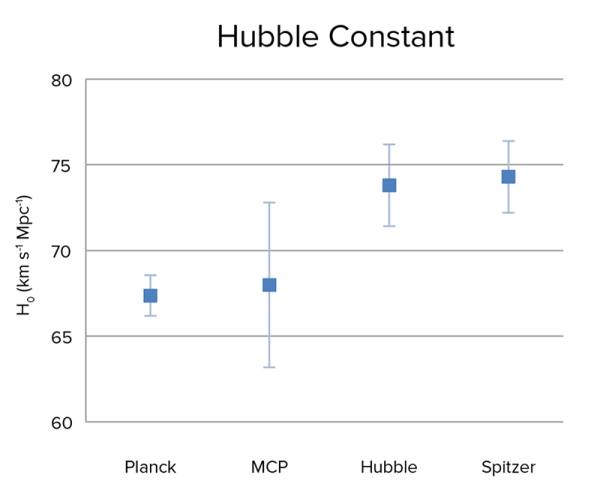 Image credit: James Braatz / NRAO. You can clearly see how the Planck results (left-most point) disagree with the Hubble results for the value of the expansion rate of the Universe.
Image credit: James Braatz / NRAO. You can clearly see how the Planck results (left-most point) disagree with the Hubble results for the value of the expansion rate of the Universe.
From MandoZink: "The default direction of science is FORWARD, even if you can’t see where you’re going."
and Michael Kelsey, on the newest on the expanding Universe: "That what we all like to think! However, the actual path of science often seems more like natural selection than progress to me"
I like the natural selection idea, personally, which is probably because it's closest to the way I do science myself. You have all these possibilities that are not ruled out, and you try to think of as many as you can when you look at the full suite of evidence. Some of them are disfavored right away, some of them are ill-motivated but not much different from more well-motivated ideas, some of them are plausible but only if observations lead to something unexpected, while finally other ones seem to fit everything simply and very well. The Lambda-CDM model for the Universe is by far the leading path on this front for the expanding Universe, but other branches are not only viable, but will need to be pursued if this evidence continues to hold up.
The Universe will still be accelerating, but if the Hubble parameter close by is ~8% faster than the Hubble parameter is at CMB-level distances, something non-uniform is occurring. Still, it could be the toughest kind of error -- a systematic error -- causing the differences. If we're simply mis-measuring the distance to the first rung on the cosmic distance ladder, then all of our rungs are off, and that "8% mismatch" could be all due to our own failings. However you view it, it's science at work!
From See Noevo on how to make a star: "So, then I wondered what caused the sun’s collecting so much matter, such that it had such incredible densities, pressures, and temperatures.
Was it gravitational force? But gravity pulling *to what* in a homogeneous universe?"
Yes, gravity pulls mass together. And yes, the Universe is homogeneous on average and on large scales. But the Sun is a small-scale structure; stars are small-scale structure; galaxies are small-scale structure. And the tiny inhomogeneities, that start off around 0.003% in magnitude, grow over time due to gravitation. So yes, the Universe is largely homogeneous, but it's not perfectly homogeneous. Write it down and remember it.
From jvj24601 on why anyone would talk about the Sun's death with a child: "Since the sun “dying” is 4 BILLION years from now, why would anyone bring up the topic with a child too young to understand the concepts involved."
Because they ask questions, and because you don't wait to stifle a curious child nor do you want to lie to them. I mean, that's assuming you are a decent human being and you want to raise a decent human being.
From Denier on having an existential crisis over technology: "The much harder one, even hard for me as an adult to grasp, is human obsolescence. We only have a handful of years left before computers are better than us at everything. [...] This isn’t something billions of years off. It will happen this century. The sun blowing up? Easy. Pointlessness? Tougher."
This is not the first time this has come up. There was a story (probably an urban legend) about an architect who did manual drafting for thirty years and was world-class at it. Someone introduced him to the latest auto-CAD software that was out there, and after an hour of experimenting with it, he killed himself. (Sounds like a tall tale, but you can see the relevance.) Right now, without a human to program the computer or guide it, you get nowhere. In the future? Computers may be able to program themselves (or other computers) better than humans ever could.
When that happens, we have to go back to the tough question we all must face: the meaning of our own existences. Of course, it's fundamentally meaningless when you think about the Universe; it will be largely unaffected by the combined sum of our existences or non-existences, just as it has been for 13.8 billion years so far. So the only meaning is the meaning we create for ourselves, through our actions and our impacts on the world and the Universe, however small they are. Perhaps -- and this is not scientific -- the last great barrier for what humans can do better than computers is to love one another?
From Ragtag Media on the Breakthrough Starshot project: "Could neutral hydrogen atoms be collected along the way and be put to use powering some form of transmitter?"
With a ~1 gram spacecraft? You're going to collect them, in the sense that they're going to collide with your sail. But they're far more likely to create atomic punctures in your sail than they are to be "collected", and how would you use them for power even if you could?
Image credit: the DEEP-laser sail concept, via http://www.deepspace.ucsb.edu/projects/directed-energy-interstellar-pre…, Copyright © 2016 UCSB Experimental Cosmology Group.
From Paul Dekous on the real reason to do this: "I think that it’s interesting that they’re trying this ‘hot air balloon’ concept, but the main reason is that it is a good ‘excuse’ to invest in nano-tech research, and get the benefits out of that to use in future appliances."
The challenge of communication, of deceleration, of collimation of the laser through the atmosphere, etc., are all huge. But the research that will go into developing the components that we do know how to presently develop will certainly have applications that are far-ranging, innovative, spectacular and -- to your point -- likely profitable as well. Will it be enough of a profit to offset the initial cost? That's the VC question, and apparently Milner thinks absolutely yes.
Image credit: Wikimedia Commons user Andrzej Mirecki, under a c.c.a.-s.a.-3.0 license, of the related solar sail concept IKAROS mission.
And finally, from PJ on using the Sun instead of a laser: "I somehow feel SOL would be a better source of power than creating artificial means of far less light pressure to achieve the required outcome. Coherent light can be compressed into a narrow beam via several optical collimators in space to give greater energy to the sail. Any laser based generator would require far more input compared to its output (inefficiency) to get a similar result."
The problem with using the Sun is exactly what you claim: pressure. Pressure, remember, is force over area, and while the Sun provides far more energy (and hence, we can derive much more force from it) than any laser system does, the Sun's energy is spread out over a tremendously large area. The difference between this laser array and the Sun, over an approximately square-meter area in low-Earth orbit, is the difference between gigaWatts (the lasers) and kilowatts (the Sun), or a factor of ~1,000,000. How are you going to build a tunable lens to collect a few square kilometers of solar energy and focus it onto a single sail as the sail's distance changes? I'm not saying it would be better, I'm saying the reason this Starshot concept is possible is because of improvements in laser technology, while we don't have this improvement in lens/solar-focusing technology. Efficiency is less of an issue when you're limited by technical challenges.
Thanks for a very thoughtful week and for making me push the limits of what I know with your questions. Hopefully I'll get to see some of you on Monday at my big Gravitational Waves talk, that some of you will get to see Mercury right after sunset this week (look to the west), and that you'll be looking forward to the next Starts With A Bang podcast -- on Planet Nine -- coming out at the end of this week. See you again soon!
- Log in to post comments



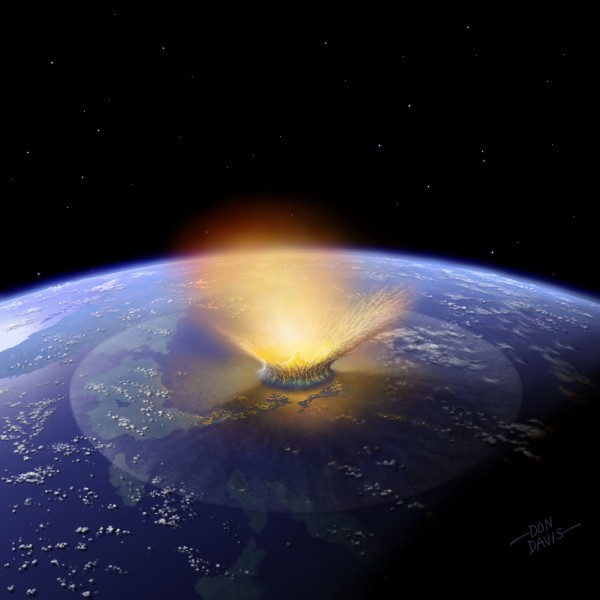
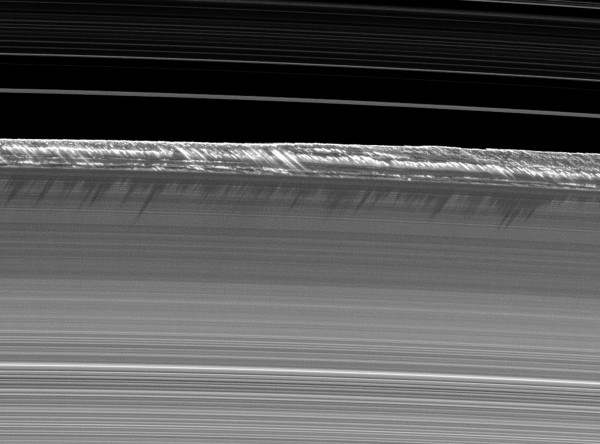
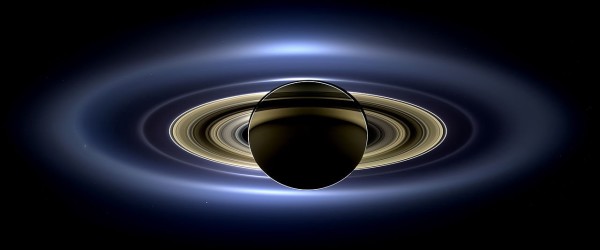
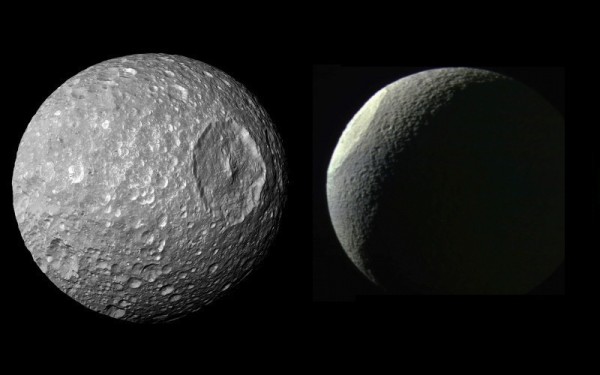
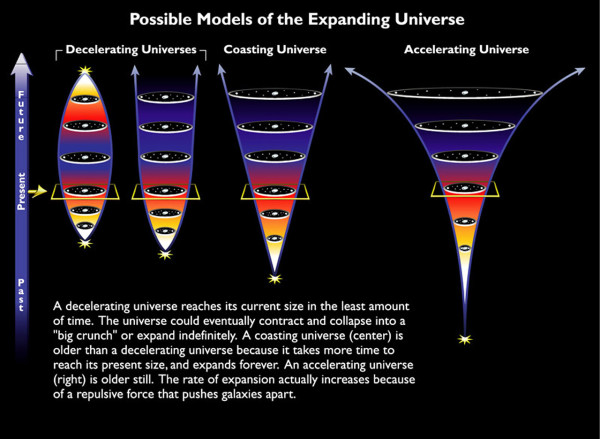
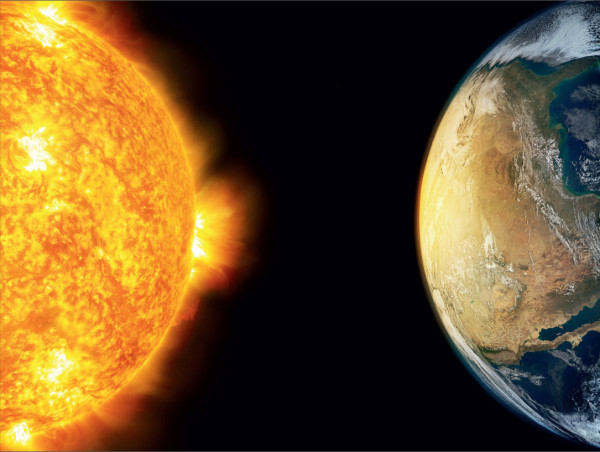
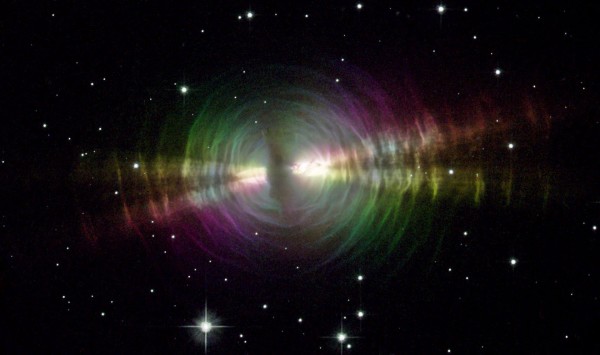
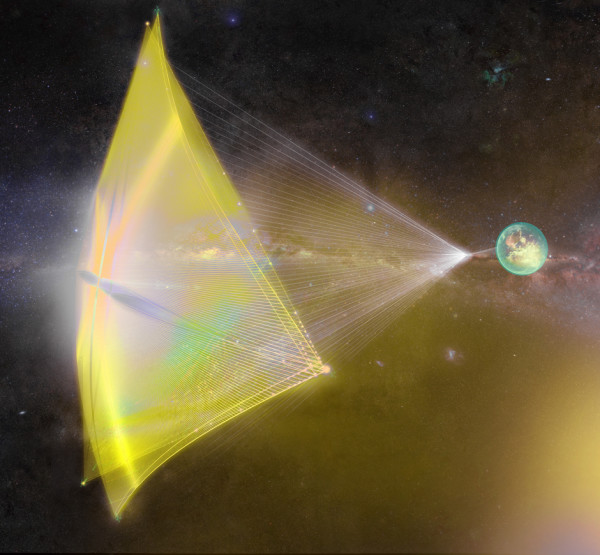

"the Universe is homogeneous on average "
Anything you want can be made homogenous on average.
What is the scale at which the universe is homogenous? How well can we observe that scale?
The chance of anything being ABSOLUTELY homogenous is ZERO.
Hell, even the chance of a strictly precise normal distribution resulting in a zero value, the PEAK value of the distribution is ZERO.
Me: “But gravity pulling *to what* in a homogeneous universe?”
Ethan: “Yes, gravity pulls mass together. And yes, the Universe is homogeneous on average and on large scales… So yes, the Universe is largely homogeneous, but it’s not perfectly homogeneous. Write it down and remember it.”
Here’s what I'll remember, Ethan:
-That the assumption of homogeneity is *required* in the Standard Cosmological Model (aka Big Bang Theory), the model that gives our universe an *age of billions of years*.
-That cosmologists are discovering very un-homogenous, very large scale stellar structures. Like 1 billion light years wide. Try Googling “BOSS Great Wall”.
And I’ll try to remember to read the rest of this paper. The author seems to be on the same wavelength as me:
“The concept of cosmological homogeneity started out as a reasonable guess about the universe, and as a mathematical device for making Einstein's equations more tractable. A few decades later, the physics/astronomy community treats cosmological homogeneity as an empirical fact. Since cosmology is recognized as a full-fledged science, one would expect that this metamorphosis from assumption to apparent fact would be strongly supported by several types of empirical evidence. The curious thing, however, is that *such evidence does not exist*. Over the years there were preliminary observations of galaxy distributions that were interpreted as supporting the homogeneity assumption. However, more refined experiments have shown that such conclusions were usually *premature and incorrect*. It is true that the microwave background radiation, which is interpreted as as a primordial remnant of matter formation, is cited as supporting the homogeneity assumption. However, there are other explanations for the origin of this radiation, and the microwave background has a decisive dipole anisotropy that may conflict with its use as evidence for homogeneity (if galactic streaming results indicate that the dipole is intrinsic and not a Doppler effect). *Most importantly the microwave background argument for homogeneity is contradicted by the more direct evidence for structural inhomogeneity right up to observational limits*. The microwave background may one day be powerful evidence for or against cosmological homogeneity, but for now it is safer to focus on the distribution of actual galactic-scale structures. As our ability to test the homogeneity assumption has improved, a *consistent string of discoveries has favored cosmological inhomogeneity* right up to the size limits of the surveys. Let us look at some of the evidence that has been grudgingly acknowledged in word, but *effectively ignored in practice by many cosmologists*.”
http://www3.amherst.edu/~rloldershaw/LOCH.HTM
"– That cosmologists are discovering very un-homogenous"
The fact that you keep remembering this is merely because you don't frigging understand that this assertion you made up IS WRONG.
wow, sn searched high and low for the one maverick unaffiliated "researcher" that has ideas almost as odd as his - not quite, as sn's assertions are based on mere stupidity and foot-stomping. oldershaw at least tries to support stuff with some math and calculations.
It's still the case that no lie is too big for you eh sn?
Hmph, this comment seems to have vanished into the ether the first time around. One more try:
You're giving S.N. too much credit – Oldershaw is invoked by the usual Flinstones-level suspects.
If he had looked further, he might have noticed that Oldershaw also seems to think that S.N.'s cherished "fine tuning" routine is a crock of sh*t.
There's nothing like being mealy-mouthed while transparently stating that you have no such intention in the first place, S.N.
A little more info FYI.
https://en.wikipedia.org/wiki/Breakthrough_Starshot
Another RL example is the human genome project: 13 years, billions of dollars, and you can probably get almost as good data now in a couple of weeks for a few tens or hundreds of dollars via a mail-in sample service. Scientific progress doesn't just alter or conclusions about how the world works, it regularly makes old methods of data collection ridiculously obsolete, replacing 'lifetimes' of human labor with 'hours' or less. No doubt the same is true in astronomy and cosmology, too, with modern instruments collecting in seconds what it would've taken took multiple person-years to collect a hundred years ago.
What this means for today's scientists is we have to think about not just what experiments we want our grad students to perform, but what skills we want to teach them that will remain relevant for their careers. Typically, that's experiment design and the sort of deep thinking needed about what experiments we really want to do. "Do the extraction" will eventually be replaced by "run the machine that does the extraction," and that will be replaced by "push this button," but there will still need to be a human to figure out what extractions to do. That's the sort of skill we need to teach our young budding scientists.
SN, if you agree with Oldershaw that the universe is not homogenous, then why did you imply star formation is a problem you don't know the answer to? Here is basically how this conversation has gone:
See Noevo: "how can stars form in a homogenous universe? Checkmate science!"
Ethan: "Its homogenous on average on a large scale, not on the scale of star-forming nebula."
See Noevo's response: "Ah ha! This scientist I found says you are wrong about it being homogenous on a large scale. Checkmate science!"
Really See, you basically just kicked the table out from underneath your original point.
To eric #10:
“SN, if you agree with Oldershaw that the universe is not homogenous, then why did you imply star formation is a problem you don’t know the answer to?”
Because they’re *both* problems for cosmologists.
Contra Big Bang Theory, the universe is *not* homogeneous at hugely-large scales (e.g. the one billion light years-wide “lump” known as the BOSS Great Wall.).
And *regardless* of whether the universe is assumed to be homogeneous or non-homogeneous, cosmologists are confounded in their theories of star formation.
For instance, Google something like “problems with star formation theory” and you’ll find a host of problems.
Here’s the first hit:
“While any new theory needs to be able to stand the test of time as it faces other competing models, it does look *possible* that we *might* finally be looking at the main way our galaxy’s biggest stars form.”
http://www.realclearscience.com/articles/2013/09/04/big_problem_in_star…
"Because they’re *both* problems for cosmologists."
No they aren't.
Your incomprehension is what makes you believe it is.
But like your other beliefs, it exists solely in your head, not in reality.
"cosmologists are confounded in their theories of star formation"
Grammatically incoherent, you plainly do not know what "confounded" means.
"For instance, Google something like “problems with star formation theory” and you’ll find a host of problems. "
And google "maths problems" and you'll see a host of problems in maths.
Therefore all maths is bunk?!?!??!
WRT laser & optical solar,
Laser:
1) laser has to be optically converged into a focusable beam before it can be used.(reduce the inherent divergence)
2) it will be earthbound for simplified service.
3) the earth rotates, ergo a constant guidance system must be employed; other than being placed at the poles, the beam will be hidden for a period of time each day, or more sites will have to take over during these transitions.
4) the beam (ground based) will be subject to atmospheric aberrations constantly, tremors.
Solar:
1) Consider a telescope eyepiece. It is designed to take light gathered from the field lens and focus it to the eye. Instead, let's use a field lens of 36" aperture (for instance). The rest of the optical chain is designed to produce a beam which can be divergently focusable to cover the 4mx4m sail of the craft.
2) Maintenance is simplified; no hungry power issues. By the time this project happens, there will be regular visits to space from the private sector & contractors.
3) In a fixed higher earth orbit, the lens system does not have to be constantly adjusted other than divergence to cover the sail. Same for the laser.
4) Used from space, there is no atmosphere to hinder the output as with ground based laser; no earthly movements, atmosphere,etc.
From these ideas, it can be seen the same focusing (diverging) technology is applicable in both cases, technology we already have.